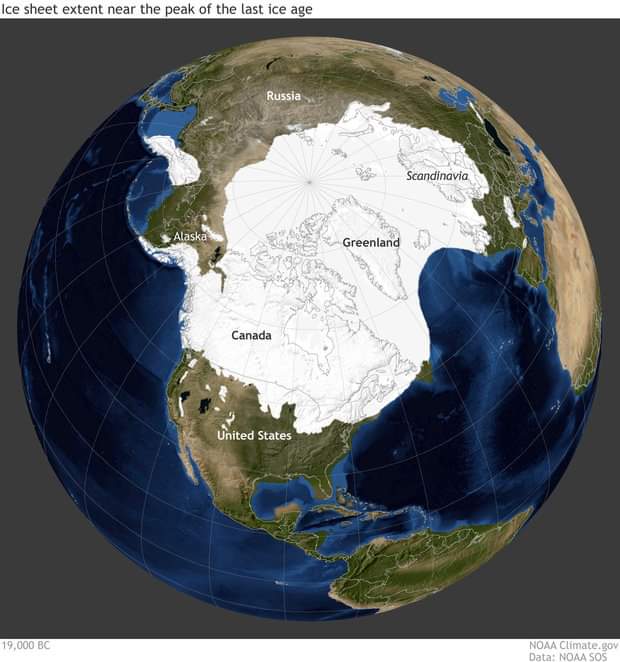1. The climates of the Earth:
1.1. hot climates
They are located between the Tropic of Cancer and Capricorn (between 0º and 30º north and south latitude) and we distinguish three types of climates:
Equatorial :
It extends through the Amazon River basin, the area of equatorial Africa, Indonesia and the islands of Papua and New Guinea. All these territories are located very close to the Equator. Its temperatures are warm all year round, between 25º and 30ºC, with few variations between summer and winter. Its rainfall is abundant (2,500 mm per year) throughout the year.
Tropical : Like the previous one, it has high temperatures and abundant rainfall. But tropical rains are distributed in two seasons: a rainy one in summer and a dry one in winter.
Steppe . It is a transitional climate located between hot desert climates and temperate climates. Its rainfall is very scarce (they do not exceed 250 mm per year) and its annual thermal amplitude is very large.
Desert : It is located near the tropics of each hemisphere. It has a very pronounced thermal oscillation between day and night, which gives rise to lower average annual temperatures than in equatorial and tropical climates. Precipitation is very scarce, less than 250 mm per year
Juanjo Romero | Geography and History
flip board
Climates and landscapes of the Earth
Juanjo Romero
Juanjo Romero
Depending on the amount of energy we receive from the Sun, the Earth is divided into three climatic zones in which different types of climates and landscapes develop: warm (intertropical), temperate and cold (polar).
Earth's climatic zones
1. The climates of the Earth.
1.1. hot climates
They are located between the Tropic of Cancer and Capricorn (between 0º and 30º north and south latitude) and we distinguish three types of climates:
Equatorial : It extends through the Amazon River basin, the area of equatorial Africa, Indonesia and the islands of Papua and New Guinea. All these territories are located very close to the Equator. Its temperatures are warm all year round, between 25º and 30ºC, with few variations between summer and winter. Its rainfall is abundant (2,500 mm per year) throughout the year.
Tropical : Like the previous one, it has high temperatures and abundant rainfall. But tropical rains are distributed in two seasons: a rainy one in summer and a dry one in winter.
Steppe . It is a transitional climate located between hot desert climates and temperate climates. Its rainfall is very scarce (they do not exceed 250 mm per year) and its annual thermal amplitude is very large.
Desert : It is located near the tropics of each hemisphere. It has a very pronounced thermal oscillation between day and night, which gives rise to lower average annual temperatures than in equatorial and tropical climates. Precipitation is very scarce, less than 250 mm per year.
1.2. temperate climates
Mediterranean . It is typical of the coast of the Mediterranean Sea, but it also occurs in other very distant coastal areas such as the west coast of the USA, Chile, South Africa and Australia. Its average annual temperature is between 10ºC and 18ºC, with hot, dry summers and mild winters. Its rainfall is very irregular (between 400 and 850 mm per year), alternating long dry periods with intense rain.
Oceanic or Atlantic. It is located in temperate zones under the influence of the sea. Its temperatures are mild throughout the year (between 10ºC and 18ºC on average). Precipitation is abundant and regular throughout the year, above 1000 mm per year.
Mainland . It occurs in temperate regions inside the continents and without the influence of the sea. Therefore, its annual thermal amplitude is very high, with very cold winters (over -30ºC) and hot summers. The annual average does not exceed 10ºC. Precipitation is scarce, greater in summer and in the form of snow in winter.
1.3. cold climates
Polar . Located in the polar circles, between 60º and 90º north and south latitude. Temperatures are usually below 0ºC. In winter they are very cold (below -50ºC) and in summer close to 0ºC. Rainfall is scarce (less than 250 mm per year) and in the form of snow.
High mountain . It develops in the great mountain ranges such as the Himalayas, the Alps or the Andes, and in other areas that exceed 2,500 meters of altitude. Its temperature is low throughout the year and is conditioned by altitude (for every 100 m of ascent, the temperature drops 1ºC) and orientation. Precipitation is abundant in the form of snow and also varies depending on the orientation with respect to the wind.
2. The landscapes of the planet
The landscape is the visible consequence of the interactions between various factors (latitude, continentality, relief) and elements (physical features, flora and fauna) that occur on the earth's surface. And according to the degree of human intervention on them we can classify them into:
Natural landscapes or biomes . They are the result of multiple combinations between the relief, the climate, the waters, the vegetation and the fauna in a specific area, without human intervention.
Humanized landscapes. They are a consequence of human intervention (new economic needs and great technological capacity) that make us the main creative and transforming agent of the landscape.
2.1. Landscapes of the warm zone
Equatorial .
The characteristic vegetation of this landscape is the equatorial forest (also called jungle in Asia). They are the spaces on the planet with the greatest biodiversity and formed by a dense vegetation of plants and trees that struggle to break through and get light to survive. The fauna of these places lives mainly in the trees: colorful birds such as parrots and macaws. In addition to a wide variety of insects, amphibians and reptiles. And numerous mammals such as primates and felines.
tropical .
It occurs in the most humid areas and close to the equator, and on the banks of rivers where the tropical forest develops (like the jungle but with more spaced trees). The most characteristic plant formation is the savannah. It is made up of herbs, bushes and few scattered trees on the plain. During the rainy season the vegetation is green and leafy, but when the dry season arrives the appearance is parched and withered. Low grasses, bushes and adapted trees such as acacia or baobab are the most characteristic. The fauna of these places is made up of large herbivores such as elephants, giraffes, wildebeests or gazelles. Also large carnivores such as leopards, lions and scavengers such as hyenas and vultures.
Deserts
Its landscape is made up of valleys of pebbles, rocky areas or dunes. It has scarce vegetation adapted to the lack of water and high temperatures, such as cacti and prickly pears. The fauna is also very scarce and adapted to the climate such as reptiles, insects, birds and small mammals. Although the camel and the dromedary are also used by man in these areas.
the temperate zone
Mediterranean . like the climate of the same name, in the coastal basins of the Mediterranean Sea, on the California coast, on the central coast of Chile, in South Africa and in southern Australia. Its vegetation is characterized by the presence of Mediterranean forests made up of evergreen trees such as pines, holm oaks and cork oaks. They are short, with a woody trunk and small leaves. Beneath this forest there is an abundance of thorny thickets (rockrose, rosemary and thyme) with small leaves that prevent moisture loss. They are adapted to the high temperatures and aridity of summer. Its fauna is varied. In the less wooded areas we find free, moles, partridges, quail, foxes, lynxes and birds of prey. And in the wooded areas herbivores such as wild boar, roe deer, along with birds and reptiles abound.
Oceanic
We find it in temperate zones with great influence from the sea. Its characteristic landscape is the deciduous forest of straight and tall trunks such as oak, beech, elm and chestnut trees. In areas where the forest has been further degraded, moorland develops, made up of bushes and thickets. And when these disappear, large grassy areas (ocean meadows) emerge. The characteristic fauna is made up of herbivores (deer and fallow deer), predators (bears, wolves and foxes) and other species of rodents and reptiles
Mainland
It develops in the interior of the continents without the influence of the sea with more extreme climates. Therefore, its plant formations, animal species and landscapes vary depending on the latitude. In the northernmost areas we find the boreal forest or taiga, made up of needle-shaped evergreen trees (conifers) that can withstand the low temperatures of winter (pines and firs). And its fauna is made up of herbivores such as elk, reindeer, deer or wild boar, rodents such as squirrels and beavers; and predators such as the bear and the wolf. Further southcontinental prairies are developed that are characterized by their wide plains covered with tall grasses. When they are close to desert regions, the steppe appears with bushes and low grasses. The fauna of these places is made up of large herbivores (bison and horses) and rodents.
the cold zone
Polar .
We must remember that in the two polar circles, due to the tilt of the Earth's axis, there are six continuous months of day and six continuous months of night. Consequently, two types of landscape are developed. The tundra that arises after the thaw and is made up of mosses, lichens and other small vegetation. The deepest part of the soil remains frozen throughout the year, which prevents the growth of plants with large roots. The other landscape is that of perpetual ice, where no vegetation grows due to surface ice. The fauna of both environments is scarce and adapted to the frigid temperatures. In Antarctica we find several species of penguins, sea lions and elephant seals. In the arctic, live various species of birds, seals, walruses, foxes and polar bears
High mountain
It develops in the great mountain ranges of the planet from 2,500 meters of altitude. It is characterized by plant formations that vary with height (bioclimatic floors) and that generate a staggering of plant species. The existing fauna adapts to the harsh conditions of temperature and altitude, with birds being the most characteristic
3. The climates and natural spaces of Europe and Spain.
3.1. Europe.
Most of the European continent is located in the temperate zone of the planet, between 35º and 60º north latitude. Temperate climates predominate, except in the northernmost area that is within the Arctic Circle and with a climate of these characteristics. We also find high mountain natural landscapes in large mountain ranges such as the Pyrenees, Alps, Bacanes, Caucasus or the Scandinavian Mountains. The influence of the Atlantic Ocean and the Mediterranean Sea softens the temperatures and causes abundant rains. The flat lands of the center and north favor the entry of humid air from the ocean and therefore rain. While in the south, the mountain ranges isolate the interior from the tempering effect of the sea. However, we distinguish up to five different types of landscapes:
Mediterranean landscape (7) . It develops along the Mediterranean coast and on the Atlantic coast of the P. Ibérica. The characteristic landscape is the Mediterranean forest made up of evergreen species (oak or cork oak) and shrubby species (rosemary, thyme, broom, heather, mastic). The fauna is varied (hares, councils, small carnivores, birds and insects).
Oceanic or Atlantic landscape (3) is characterized by deciduous forests that lose their leaves in autumn and winter (oak, beech, chestnut, etc.) and heathlands. As for the fauna, mammals, birds, insects, etc. abound.
mainland landscape
Made up of very thick and dark coniferous or taiga (2) forests with evergreen trees (pines and firs). Winters are harsh and animals migrate to more temperate latitudes. Forest exploitation is one of the main economic activities. At lower latitudes we find a mixed forest (4) of conifers and deciduous trees (oak, beech and chestnut). And in the central zone of Europe and the P. Ibérica, the vegetation that predominates is the steppe (9) (wide extensions of herbaceous plants) that feed bison, horses and numerous birds.
High mountain landscape (5) . It develops in the great mountain ranges indicated above. They house a landscape staggered in height that goes from the cultivation areas in the lower parts, to deciduous forests, conifers, alpine meadows and perpetual snow on the upper floors.
Polar landscape (1) . It is located in the northernmost areas of Europe (Iceland, northern Scandinavia and archipelagos north of Russia). The landscape is covered in snow most of the year, and when summer arrives and the ice disappears, the tundra appears (shrubs, lichens and mosses
3.2. Spain
Our country is located on the Iberian Peninsula in the southwest of the European continent. The climates that develop in the P. Ibérica are conditioned by:
The four seasons caused by its location in the temperate zone.
Its location on the west side of Europe allows it to receive the influence of the Atlantic Ocean and the Mediterranean Sea, and the European and African continents.
The massive shape of the Peninsula and the layout of the mountain ranges prevent the marine influence in the interior of the peninsula.
Westerly winds and Atlantic storms cause the rains.
The anticyclone located over the Azores islands is responsible for the absence of rain during the summer

.jpeg)
.jpeg)
.jpeg)






